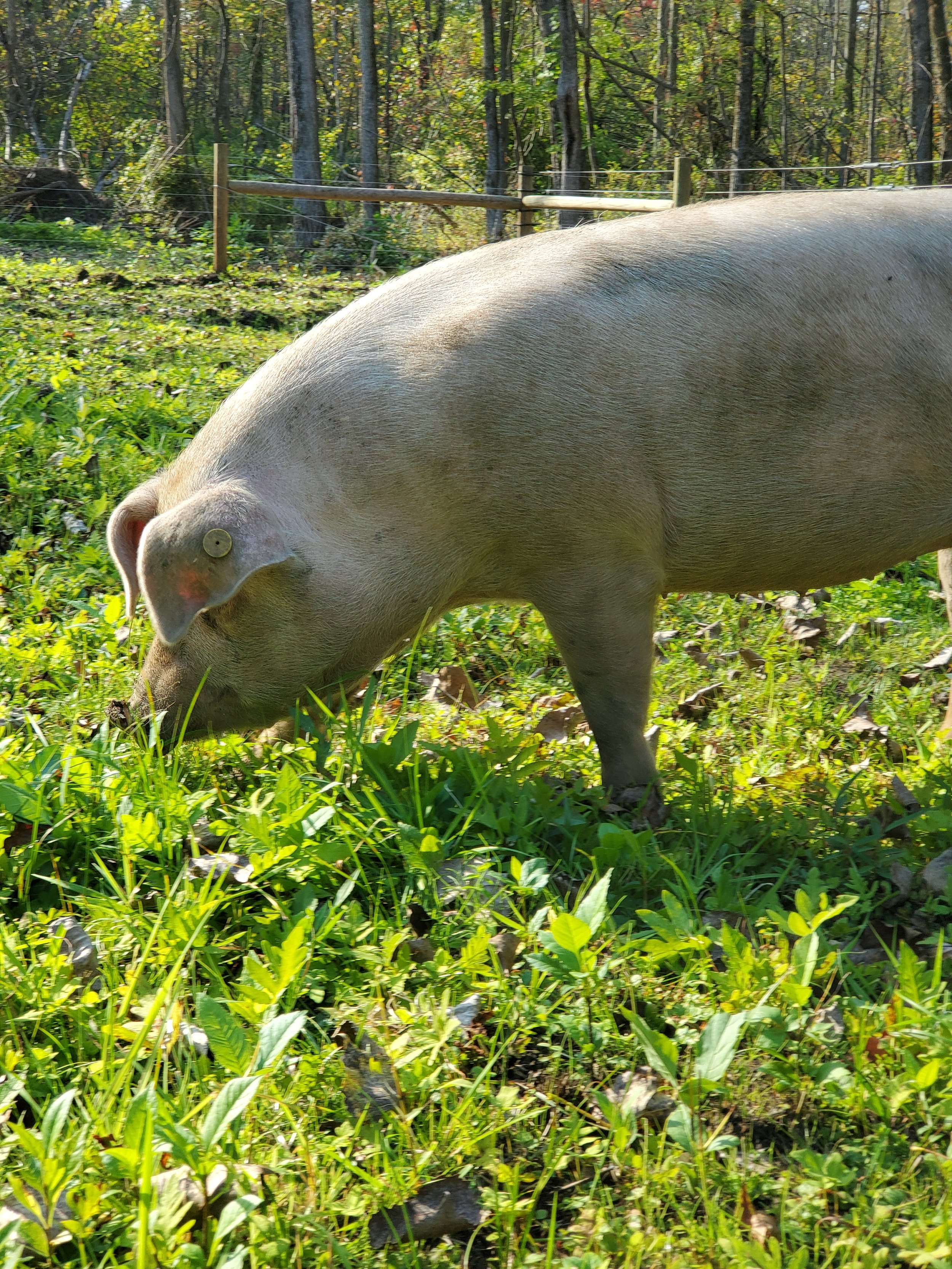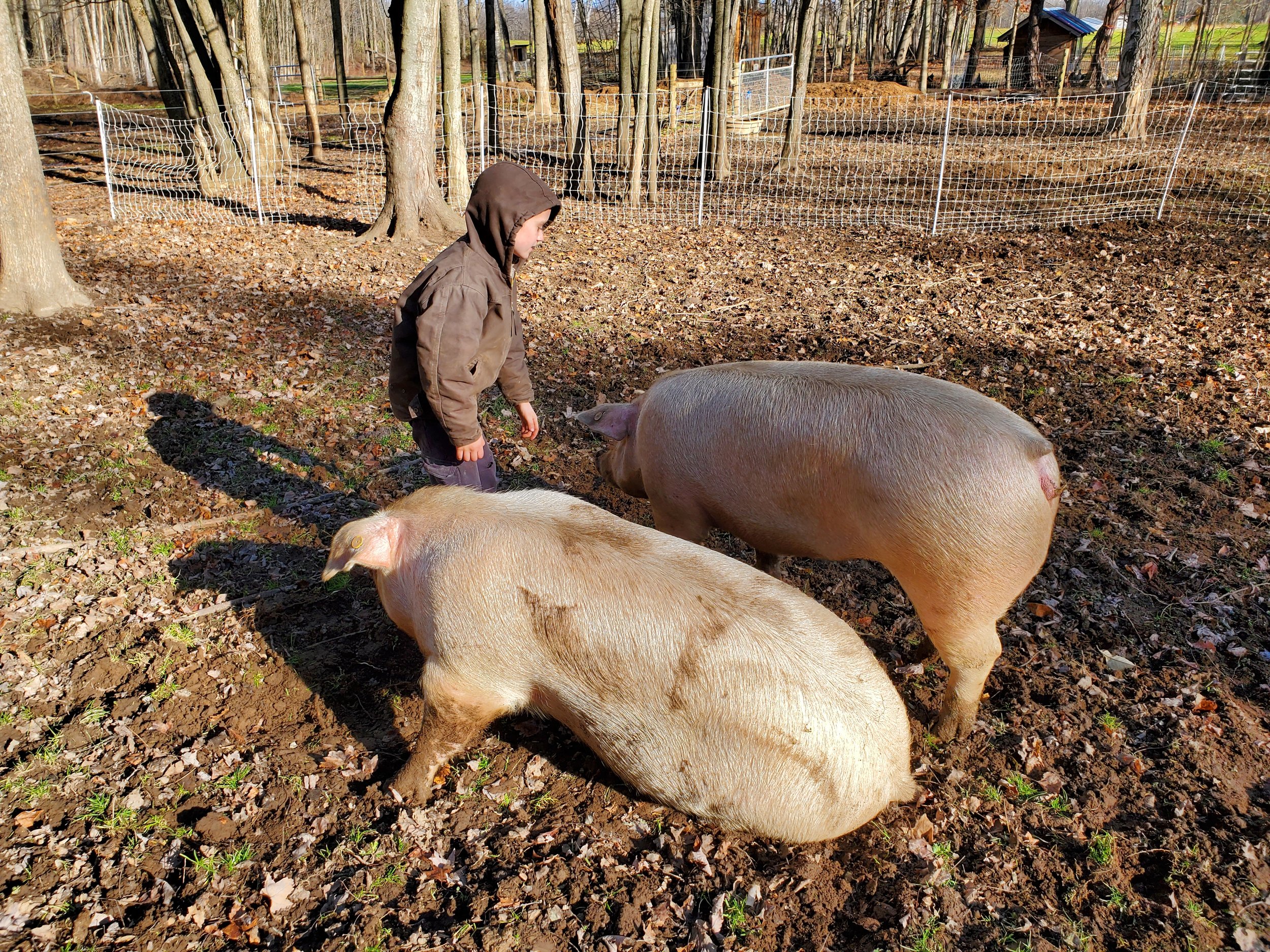
Pasture Raised Pigs
What is Pastured Pork?
Some pigs live in cages. Some pigs live in barns. Our pigs live in pastures. The pigs forage, eating whatever they find appetizing, with a supplemented diet of non-GMO grain. With the sun on their back and the wind on their face, they are happy pigs.
![20210426_200746[1].jpg](https://images.squarespace-cdn.com/content/v1/60637d2c14567f2836dcd6fe/39691dfa-9d58-4364-8d7d-115a8df38ef6/20210426_200746%5B1%5D.jpg)





![20201015_113628[1].jpg](https://images.squarespace-cdn.com/content/v1/60637d2c14567f2836dcd6fe/d71d68ae-4942-41b6-8abf-eff64a525510/20201015_113628%5B1%5D.jpg)
![20200617_110606[1].jpg](https://images.squarespace-cdn.com/content/v1/60637d2c14567f2836dcd6fe/aadb6c9b-f560-4822-85e0-697ff92aa58b/20200617_110606%5B1%5D.jpg)



What to expect when buying a full pig
Our pig’s diet is comprised of forage from being on pasture, non-GMO grain from Original Feeds, and fresh veggies from friendly neighbors who’s gardens gave more than they could use.
We try to finish the pigs out at a live weight between 250 and 300 lbs. The hanging weight will be approximately 70% of that with the final meat-in-the-freezer weight around 70% of the hanging weight. This depends on what cuts/trimmings you want from the butcher.
Once you have selected a butcher, call them and ask questions. Ask about their “typical fee” for a whole hog, but it tends to be between $200 and $400 depending on what options you select.
As a rule of thumb, when you are buying a whole pig, budget $1,500. By the time all is said and done, you will probably end up paying $5 - $7/lb for the commercial cuts in the freezer.
Having Trouble on Pork Cuts?
Watch this video which does an excellent job detailing how a pig is broken down into the different cuts of pork.
A couple of interesting articles
How Pharma Hides Data About Farm Antibiotic UseNutrition in Pastured Pork
In pork, one big issue is fat quality. This comes pretty much directly from their diet. In the wild, pigs eat pretty much anything they can get their snouts into: roots, grass, leaves, grubs, nuts (most famously hazelnuts and acorns), berries and fruit, and insects. Under human care, they’ll also happily eat table scraps with no ill effect, provided those table scraps came from healthy food in the first place.
Contrast that with the typical diet for factory-farmed pigs, which is largely based on corn and soybean meal, together with all the disgusting additions mentioned above. This feed is very high in Omega-6 PUFA, and the more Omega-6 fats in the pig’s diet, the more will be in the meat.
(A brief review of what these numbers mean: for optimal health, you want to get a relatively low amount of overall PUFA, with a low ratio of Omega-6 (inflammatory) to Omega-3 (anti-inflammatory). The best ratio of O6:O3 is between 1:1 and 4:1. For more details, you can read about the whole issue here.)
Getting back to the pork, a 2012 review that tried to make an overall comparison between free-range and factory-farmed pork had a difficult time, because the studies found widely different results. Some found no significant difference at all; others found the free-range pork to be anywhere from 18% to 291% higher in Omega-3s, with a difference in O6:O3 ratio anywhere from 7% to 42%. Whenever there was a difference, it was a difference in favor of the free-range animals.
This variation in results is frustrating but not surprising. First of all, not all pigs are the same; it’s unreasonable to expect totally uniform results. The type of plants on the pasture can also have an effect. Then you have to consider that all these studies raised the pigs in different ways. It would really be more surprising if the research all agreed!
Even with the different results, though, it’s clear that the pastured pigs are coming out on top. The reasons for this aren’t hard to figure out:
Truly pastured pigs get more Omega-3s. Green grass and leaves are major sources of Omega-3 fats in animal diets – these are foods available to truly pastured pigs, but not to “free-range” pigs that actually live in a barn. And there’s a lot of evidence that feeding acorns increases the Omega-3 content and MUFA content of the meat. In other words, pigs eating their natural diet get a lot more Omega-3s than pigs in a factory farm.
The effect of dietary Omega-3s is very significant. One group of researchers studied two groups of pigs. One group of pigs ate a diet supplemented with 5% linseed oil (very high in Omega-3 fat); the other group was the control. At the end of the study, ham made from the Omega-3 group had an O6:O3 ratio of 2.5:1 (healthy), while ham made from the control group had a ratio of 12:1 (less healthy).
Looking at these two facts, it seems reasonable that the truly pastured pigs (as opposed to “free-range” pigs that really aren’t) would be on the high end of the benefit spectrum. All pigs have a fairly high O6:O3 ratio, but the pastured pigs are the clear winners compared to their factory-farmed cousins.
The results for micronutrient content are less impressive. For Vitamin E, the 2012 review found that free-range pork provides 1.7-5% of the RDA, compared to 0.8-2.5% for CAFO pork. For iron, the difference was even smaller: 3.6% for free-range vs. 1.1% for CAFO. This could potentially make a difference if pork is your only source of Vitamin E or iron, but it’s not extremely significant in the context of an otherwise balanced diet.
The upshot: pastured pork doesn’t necessarily have more micronutrients, but its fat quality is likely to be significantly better, as long as it was truly raised on a pasture and allowed to eat a natural diet including green plants and acorns.



